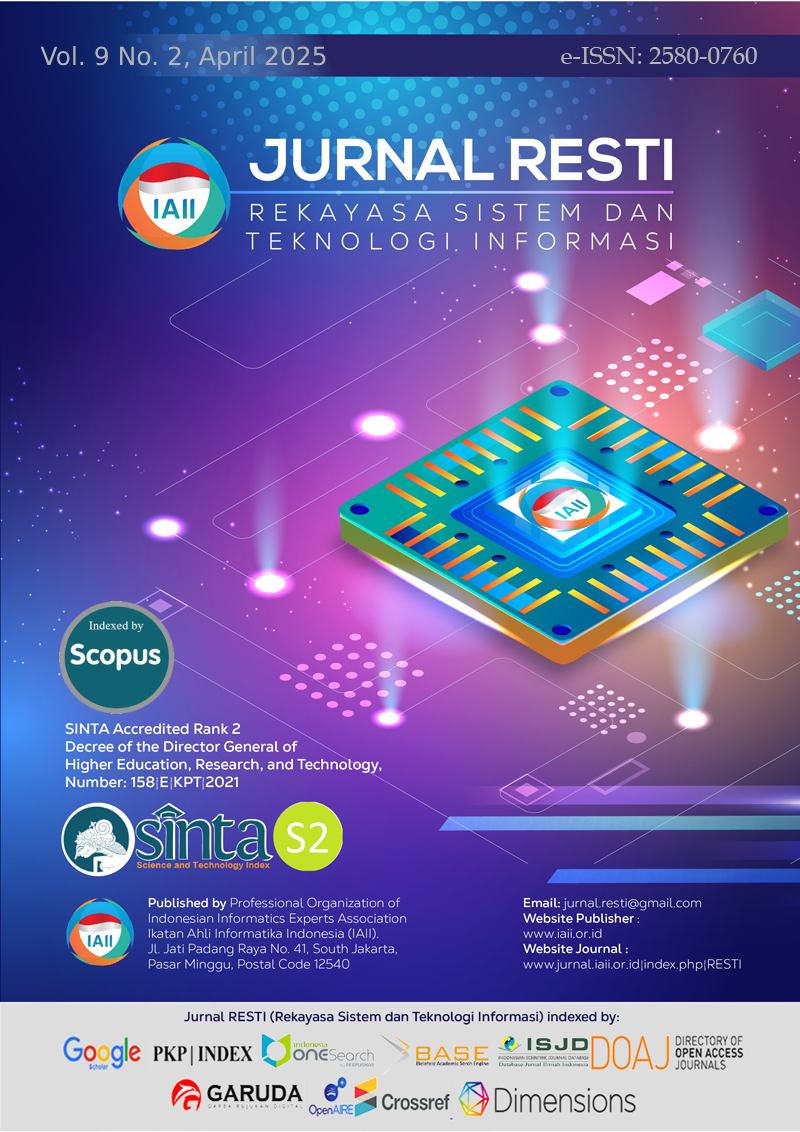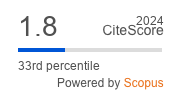Multi-Process Data Mining with Clustering and Support Vector Machine for Corporate Recruitment
Abstract
Having an efficient and accurate recruitment process is very important for a company to attract candidates with professionalism, a high level of loyalty, and motivation. However, the current selection method often faces problems due to the subjectivity of assessing prospective employees and the long process of deciding on the best candidate. Therefore, this research aims to optimize the recruitment process by applying data mining techniques to improve efficiency and accuracy in candidate selection. The method used in this research utilizes a multi-process Data Mining approach, which is a combination of clustering and classification algorithms sequentially. In the initial stage, the K-Means algorithm is applied to cluster candidates based on administrative selection data, such as document completeness and reference support. Next, a classification model was built using a Support Vector Machine (SVM) to categorize the best candidates based on the results of psychological tests, medical tests, and interviews. The experimental results show that the SVM model produces high evaluation scores, with an AUC of 87%, Classification Accuracy (CA) of 90%, F1-score of 89%, Precision of 91%, and Recall of 90%. With these results, it can be concluded that this model is able to improve accuracy in the employee selection process and help companies make more measurable and data-based recruitment decisions.
Downloads
References
Z. Zhao, “Research on Marketing Strategies of Enterprise in the Context of the Digital Economy,” Adv. Econ. Manag. Polit. Sci., vol. 91, no. 1, pp. 173–179, 2024, doi: 10.54254/2754-1169/91/20241055.
G. Boehncke, “Talents for future – do top talents care about CSR corporate communication in recruiting? An empirical study,” Soc. Responsib. J., 2024, doi: 10.1108/SRJ-11-2023-0623.
G. Koman, P. Boršoš, and M. Kubina, “Sustainable Human Resource Management with a Focus on Corporate Employee Recruitment,” Sustain., vol. 16, no. 14, 2024, doi: 10.3390/su16146059.
Muhammad Haris Diponegoro, Sri Suning Kusumawardani, and Indriana Hidayah, “Tinjauan Pustaka Sistematis: Implementasi Metode Deep Learning pada Prediksi Kinerja Murid,” J. Nas. Tek. Elektro dan Teknol. Inf., vol. 10, no. 2, pp. 131–138, 2021, doi: 10.22146/jnteti.v10i2.1417.
O. Avci, O. Abdeljaber, S. Kiranyaz, M. Hussein, M. Gabbouj, and D. J. Inman, “A review of vibration-based damage detection in civil structures: From traditional methods to Machine Learning and Deep Learning applications,” Mech. Syst. Signal Process., vol. 147, 2021, doi: 10.1016/j.ymssp.2020.107077.
L. Ghedabna, R. Ghedabna, Q. Imtiaz, A. Faheem, A. Alkhayyat, and M. S. Hosen, “" Artificial Intelligence in Human Resource Management : Revolutionizing Recruitment , Performance , and Employee Development ",” vol. 10, pp. 52–68, 2024.
M. A. Ahmadi, R. Ayuningtyas Fachrunisa, A. Baihaqi, F. Kurniawan, M. Ilham, and T. Abdillah, “Transforming Human Resources Recruitment: The Impact of Artificial Intelligence (AI) on Organizational Attractiveness and Applicant Intent,” Benefit J. Manaj. dan Bisnis, vol. 9, no. 1, pp. 99–114, 2024.
L. Hoki, V. Augusman, and T. Informatika, “PENERAPAN MACHINE LEARNING UNTUK MENGATEGORIKAN SAMPAH,” vol. X, no. 1, pp. 1–5, 2021.
K. Fukami, K. Fukagata, and K. Taira, “Machine-learning-based spatio-temporal super resolution reconstruction of turbulent flows,” 2021, doi: 10.1017/jfm.2020.948.
C. Zhang, J. Lu, and Y. Zhao, “Generative pre-trained transformers (GPT)-based automated data mining for building energy management: Advantages, limitations and the future,” Energy Built Environ., vol. 5, no. 1, pp. 143–169, 2024, doi: 10.1016/j.enbenv.2023.06.005.
A. A. Aldino, D. Darwis, A. T. Prastowo, and C. Sujana, “Implementation of K-Means Algorithm for Clustering Corn Planting Feasibility Area in South Lampung Regency,” J. Phys. Conf. Ser., vol. 1751, no. 1, 2021, doi: 10.1088/1742-6596/1751/1/012038.
Y. Chen and R. Pan, “Research on Data Analysis and Visualization of Recruitment Positions Based on Text Mining,” Adv. Multimed., vol. 2022, 2022, doi: 10.1155/2022/9047202.
L. Sun, X. Cao, and D. Su, “Statistical Analysis of Online Recruitment Information Based on Text Mining Technology,” in 2022 International Conference on Intelligent Transportation, Big Data & Smart City (ICITBS), 2022, pp. 431–436.
Q. Miao, “Data mining design for development job recruitment in Wuhan,” in 2022 2nd International Symposium on Artificial Intelligence and its Application on Media (ISAIAM), 2022, pp. 107–112.
H. Li and N. Hu, “Data Clustering Mining Method of Social Network Talent Recruitment Stream Based on MST Algorithm,” in International Conference on Advanced Hybrid Information Processing, 2022, pp. 99–111.
M. Shi, H. Zhou, and Z. Lang, “Design and Implementation of Employment Information Data Collection System Based on Data Mining Technology,” in 2024 3rd International Conference on Artificial Intelligence and Autonomous Robot Systems (AIARS), 2024, pp. 795–799.
N. Hendrastuty, “Penerapan Data Mining Menggunakan Algoritma K-Means Clustering Dalam Evaluasi Hasil Pembelajaran Siswa,” J. Ilm. Inform. Dan Ilmu Komput., vol. 3, no. 1, pp. 46–56, 2024.
K. Chowdhury, D. Chaudhuri, and A. K. Pal, “An entropy-based initialization method of K-means clustering on the optimal number of clusters,” Neural Comput. Appl., vol. 33, no. 12, pp. 6965–6982, 2021, doi: 10.1007/s00521-020-05471-9.
M. Jahangoshai Rezaee, M. Eshkevari, M. Saberi, and O. Hussain, “GBK-means clustering algorithm: An improvement to the K-means algorithm based on the bargaining game,” Knowledge-Based Syst., vol. 213, p. 106672, 2021, doi: 10.1016/j.knosys.2020.106672.
H. A. Ulvi and M. Ikhsan, “Comparison of K-Means and K-Medoids Clustering Algorithms for Export and Import Grouping of Goods in Indonesia,” Sinkron, vol. 8, no. 3, pp. 1671–1685, 2024, doi: 10.33395/sinkron.v8i3.13815.
W. Apriliah, I. Kurniawan, M. Baydhowi, and T. Haryati, “Prediksi Kemungkinan Diabetes pada Tahap Awal Menggunakan Algoritma Klasifikasi Random Forest,” Sistemasi, vol. 10, no. 1, p. 163, 2021, doi: 10.32520/stmsi.v10i1.1129.
U. Rahamathunnisa, M. K. Nallakaruppan, A. Anith, and K. S. S. Kumar, “Vegetable Disease Detection Using K-Means Clustering and Svm,” 2020 6th Int. Conf. Adv. Comput. Commun. Syst. ICACCS 2020, pp. 1308–1311, 2020, doi: 10.1109/ICACCS48705.2020.9074434.
S. Saikin, S. Fadli, and M. Ashari, “Optimization of Support Vector Machine Method Using Feature Selection to Improve Classification Results,” JISA(Jurnal Inform. dan Sains), vol. 4, no. 1, pp. 22–27, 2021, doi: 10.31326/jisa.v4i1.881.
N. Tilapia and U. Arduino, “JITE ( Journal of Informatics and Telecommunication Engineering ) Automation of Aquaponic Choy Sum and Nile Tilapia Using Arduino,” vol. 4, no. January, 2021.
F. Zamachsari and N. Puspitasari, “Penerapan Deep Learning dalam Deteksi Penipuan Transaksi Keuangan Secara Elektronik,” J. RESTI (Rekayasa Sist. dan Teknol. Informasi), vol. 5, no. 2, pp. 203–212, 2021, doi: 10.29207/resti.v5i2.2952.
R. M. Arias Velásquez, “Support vector machine and tree models for oil and Kraft degradation in power transformers,” Eng. Fail. Anal., vol. 127, no. April, 2021, doi: 10.1016/j.engfailanal.2021.105488.
R. Sistem and F. Bencana, “JURNAL RESTI Algoritma Fungsi Perlatihan pada Machine Learning berbasis ANN,” vol. 1, no. 10, pp. 254–264, 2021.
Copyright (c) 2025 Jurnal RESTI (Rekayasa Sistem dan Teknologi Informasi)

This work is licensed under a Creative Commons Attribution 4.0 International License.
Copyright in each article belongs to the author
- The author acknowledges that the RESTI Journal (System Engineering and Information Technology) is the first publisher to publish with a license Creative Commons Attribution 4.0 International License.
- Authors can enter writing separately, arrange the non-exclusive distribution of manuscripts that have been published in this journal into other versions (eg sent to the author's institutional repository, publication in a book, etc.), by acknowledging that the manuscript has been published for the first time in the RESTI (Rekayasa Sistem dan Teknologi Informasi) journal ;








